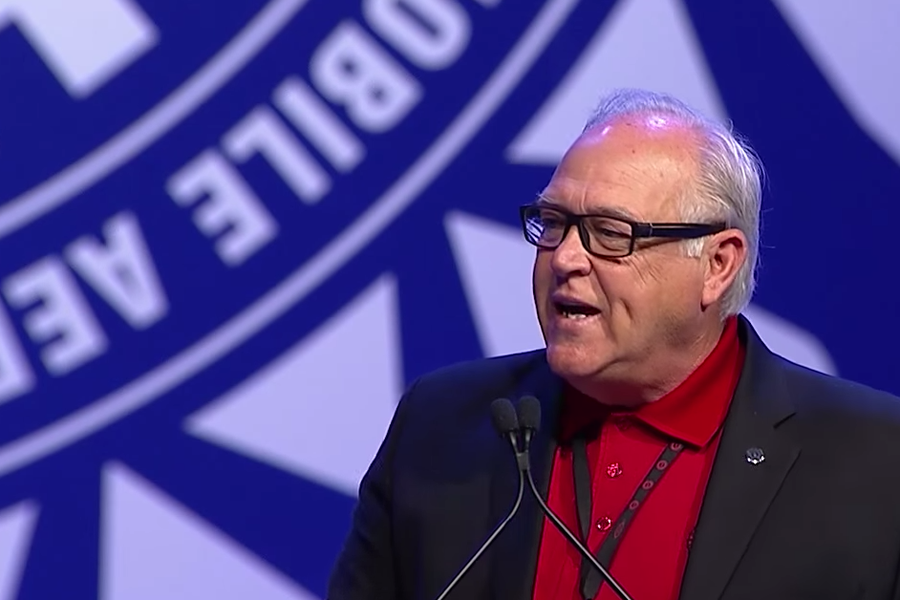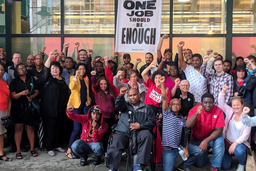
“What’s good for General Motors is good for America,” GM President Charles Wilson once reportedly said offhand in 1953, when the giant automaker was near the height of its corporate power. Wilson’s sentiment would be ridiculed in the years that followed, but the symbolic importance of the company to the U.S. industrial economy was re-emphasized as recently as 2012, when Vice President Joe Biden bragged about the successes of the Obama-Biden administration with the unofficial re-election slogan “Bin Laden is dead and GM is alive.”
Biden’s boasting about the 2009 government rescue of the bankrupt GM served as an informal starting point in Detroit March 24-25, when some 900 leaders of the United Auto Workers met for the union’s 2015 Special Bargaining Convention. At the top of the agenda was discussion of a strategy for collective bargaining with GM and other large automakers — the first such contract negotiation since the so-called “Detroit Three” auto companies recovered from the spectacular financial collapse of 2008.
It’s no surprise then that a dominant theme of the UAW Convention was “It’s Our Time” — shorthand for the rank-and-file feeling that the union’s decade-long era of concessions, wage freezes and other givebacks to the auto industry should finally come to an end. GM, Ford Motor Co. and Chrysler (now called Fiat Chrysler Automobiles to reflect its 2012 purchase by Italy-based multinational Fiat) have all reported strong profits in recent years, and this new prosperity in prompting widespread calls from within the union for broad-based wage increases, and other improvements to the existing collective bargaining agreements
UAW President Dennis Williams is well aware that members are demanding raises, but has been careful not to raise expectations too high. Since succeeding Bob King as union president last June, Williams has focused mostly on attacking the two-tier wage system instituted in 2007 as a concession to the then-ailing car companies. He has made continued calls to “bridge the gap” between the veteran UAW members and the lower-paid ‘Tier 2’ autoworkers who have been hired more recently. (UAW declined a request from In These Times for an interview with Williams on the subject of UAW negotiations.)
The gap between the tiers can be substantial indeed. A recent news story from the Detroit Free Press stated that the second-tier wage for new workers starting at GM plants can be as low as $15.78 an hour, compared to an average $28 an hour for veteran UAW members.
Steven Rattner, the New York financier and journalist who led the Obama administration’s auto bailout team, agrees with Williams that reforming the two-tier system should be at the top of the union’s GM agenda.
“I’ve always felt that the two tier was a bad idea,” he says. But it’s “not a viable option right now” to eliminate it entirely. Rather, labor and management should aim at the compromise suggested by Williams to reduce the worst inequities created by the two-tier system this year and slowly phase it out over time, he says. “What’s important is to keep labor cost increases” under control, so that GM remains competitive against its auto company rivals, Rattner claims.
The banker and journalist (he authored the 2010 memoir Overhaul on his experience leading the Obama auto rescue team) adds that the upcoming contract negotiations don’t have much meaning for the rest of labor or the larger industrial economy: “The new contract is important to GM and to the UAW, but I don’t think it matters very much to anybody else.”
Indeed, GM’s fall as industrial giant is reflected in some of the recent employment numbers. The union represented just 48,513 GM workers in 2014, a UAW spokesperson says, and has fallen behind Ford as the leading auto employer (Ford employed 50,450 workers represented by the union in the same period). GM workers now represent about 12 percent of the union’s total membership of 403,466.”
Similar thoughts were expressed by Nelson Lichtenstein, Professor of History at the University of California Santa Barbara and author of a biography of the legendary UAW President Walter Reuther. “GM, and the auto industry in general, are just a smaller part of the economy than they used to be. I don’t think [the GM-UAW contract] is a bellwether for the economy, or for anything else,” he says.
The contraction of the U.S. auto companies over the last 10 years means that they no longer influence industry-wide standards, Lichtenstein explains. Japan’s Toyota, for example, first surpassed GM as the world’s largest automaker in 2008, and Germany’s Volkswagen supplanted GM in the number two spot in 2013. “The labor market standards for auto plants in the U.S. are set by the transplants — the Japanese and German companies with assembly operations in the non-union South. Nobody cares about GM or Ford,” he says.
Rattner and Lichtenstein’s comments were indirectly confirmed by Fred Swanner, President of UAW Local 239 in Baltimore. During a tour last year of GM’s White Marsh, Maryland, plant, Swanner acknowledged that UAW employment in the area is a shadow of its former self. While the suburban White Marsh plant is a modern facility employing about 300 workers, the union lost some 5,000 GM jobs with the 2005 closure of the company’s urban Broening Highway assembly complex.
Local 239 is enthusiastic that GM decided to open a new production line for electric motors at White Marsh in 2013, Swanner says, but the wide disparity in wages for the second-tier workers hired for the electric motor line compared to the veteran workers already at work on the plant’s separate transmissions line is a touchy issue.
So as the UAW prepares for contentious contract negotiation with GM, the assertions of Charles Wilson and Joe Biden seem less and less relevant. Despite the government bailout, General Motors is declining as an industrial force, and neither the UAW nor any other union has any ability to change that. Yes, General Motors is important to thousands of workers. But it’s hard to argue that GM matters for the rest of the country anymore.







